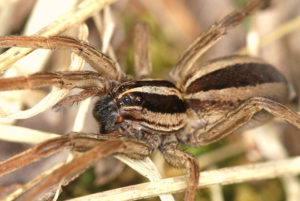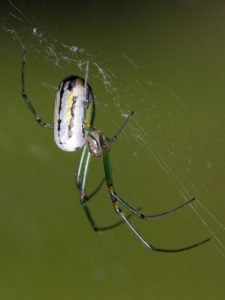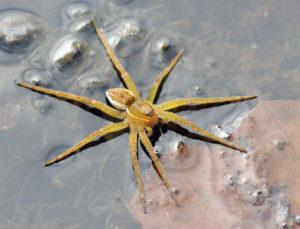Wildlife Wednesday: Spiders of the Nature Discovery Center
To celebrate Ms. Jenny’s arachnid themed Summer Science Camp this week, I thought we should dedicate this week’s WW to common spiders of the Nature Center. Spiders are arachnids, along with scorpions, daddy-long-legs, Camel Spiders, and Whip Scorpions (amongst others). Spiders have 2 body sections (the abdomen and the cephalothorax), 8 legs, 2 front arms called pedipalps, and usually have 8 eyes. All spiders are predatory, and use venom to subdue and digest their prey, though none of the species in our park are seriously venomous enough to harm people.
 The Carolina Wolf Spider (Hogna carolinensis) is one of the most commonly seen spiders here, especially under rocks and logs. They are free roaming spiders, and do not inhabit webs. They’re often encountered this time of year carrying an egg sac, or carrying around dozens of babies on their backs. These large brown spiders are often mistaken for tarantulas, but they’re not quite as hairy, and not quite as large. Though the venom isn’t medically injurious to humans, it is painful, so you should avoid handling this spider.
The Carolina Wolf Spider (Hogna carolinensis) is one of the most commonly seen spiders here, especially under rocks and logs. They are free roaming spiders, and do not inhabit webs. They’re often encountered this time of year carrying an egg sac, or carrying around dozens of babies on their backs. These large brown spiders are often mistaken for tarantulas, but they’re not quite as hairy, and not quite as large. Though the venom isn’t medically injurious to humans, it is painful, so you should avoid handling this spider.
Orchard Orbweavers (Leucage venusta) are commonly found hanging out on webs found on bushes, trees, and other low vegetation all throughout the park. As with other orbweavers, the female constructs a typical orbweb, but also constructs other protective silk web structures around the main web, making it a little more complex than many other orbweaver webs. The males are much smaller, and hang out around the edges of the web, venturing in occasionally to steal food and mate with the female (if they’re able to avoid getting killed and eaten by the female). This little spider is easily identified by the bright orange spots that appear on the bottom of the abdomens of older females.
 A really awesome spider, found only in the Cypress Pond at the South End of the park, is the Six-spotted Fishing Spider (Dolomedes triton), which is known for running across the surface of the water. These large leggy water walkers prey on a wide variety of aquatic creatures, like: minnows, tadpoles, aquatic insects, and even other spiders!
A really awesome spider, found only in the Cypress Pond at the South End of the park, is the Six-spotted Fishing Spider (Dolomedes triton), which is known for running across the surface of the water. These large leggy water walkers prey on a wide variety of aquatic creatures, like: minnows, tadpoles, aquatic insects, and even other spiders!
I hope you enjoyed this brief look at common and fascinating spiders at the Nature Discovery Center, and that you get a chance to go out look for them in the park sometime.
Thanks for joining us, see you soon!
Eric Duran
Staff Naturalist
Photographs: Top image – Wolf spider face by Thomas Shahan (Wikimedia); Wolf Spider by John Flannery (Flickr); Orchard Orbweaver by Kaldari (Wikimedia); Fishing Spider by Stephen Little (Flickr)



